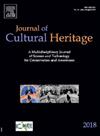An electrochemical method for reinforcing marble stone: The deposition of aluminium phosphate materials
IF 3.5
2区 综合性期刊
0 ARCHAEOLOGY
引用次数: 0
Abstract
In recent years, aluminium phosphate has demonstrated promising results in reinforcing and protecting marble stone relics. However, there is still room for improvement in terms of permeability and coating continuity. In this study, an electrochemical deposition method was utilized to reinforce simulated weathered marble, employing diammonium phosphate as the cathodic reaction raw material and aluminium chloride as the anodic reaction raw material. The protective mechanism of this method was analyzed using SEM-EDS, and the effectiveness and compatibility were evaluated by testing wettability, surface free energy, surface roughness, porosity, acid corrosion resistance, water vapor transmission rate and color difference. The results revealed that, uniform deposition of aluminium phosphate led to a reduction in the surface free energy and porosity, but an increase in water droplet penetration time of the reinforced marble. These changes significantly improved the acid erosion resistance of the marble. Furthermore, this reinforcement method can maintain good compatibility of the reinforced marble in terms of color and breathability. The electrochemical deposition method utilizing diammonium hydrogen phosphate and aluminium chloride as the main materials exhibits substantial potential in weathering-resistant reinforcement of marble stone relics.
加固大理石石材的电化学方法:磷化铝材料的沉积
近年来,磷酸铝在加固和保护大理石文物方面取得了可喜的成果。然而,在渗透性和涂层连续性方面仍有改进的余地。本研究以磷酸二铵为阴极反应原料,氯化铝为阳极反应原料,采用电化学沉积法加固模拟风化大理石。利用扫描电子显微镜-电子显微镜分析了这种方法的保护机制,并通过测试润湿性、表面自由能、表面粗糙度、孔隙率、耐酸腐蚀性、水蒸气透过率和色差来评估其有效性和兼容性。结果表明,磷酸铝的均匀沉积降低了增强大理石的表面自由能和孔隙率,但增加了水滴渗透时间。这些变化大大提高了大理石的抗酸侵蚀能力。此外,这种增强方法还能使增强大理石在颜色和透气性方面保持良好的兼容性。以磷酸氢二铵和氯化铝为主要材料的电化学沉积法在大理石文物的抗风化加固方面具有巨大潜力。
本文章由计算机程序翻译,如有差异,请以英文原文为准。
求助全文
约1分钟内获得全文
求助全文
来源期刊

Journal of Cultural Heritage
综合性期刊-材料科学:综合
CiteScore
6.80
自引率
9.70%
发文量
166
审稿时长
52 days
期刊介绍:
The Journal of Cultural Heritage publishes original papers which comprise previously unpublished data and present innovative methods concerning all aspects of science and technology of cultural heritage as well as interpretation and theoretical issues related to preservation.
 求助内容:
求助内容: 应助结果提醒方式:
应助结果提醒方式:


